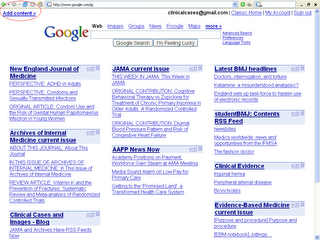 This is a collection of articles I have found interesting in the weekly editions of the "big five" medical journals: NEJM, JAMA, Annals, Lancet and BMJ (a few more journals are included occasionally). The review is a weekly feature of Clinical Cases and Images - Blog.
This is a collection of articles I have found interesting in the weekly editions of the "big five" medical journals: NEJM, JAMA, Annals, Lancet and BMJ (a few more journals are included occasionally). The review is a weekly feature of Clinical Cases and Images - Blog.Effect of Variation in CHI3L1 on Serum YKL-40 Level, Risk of Asthma, and Lung Function. NEJM, 04/2008.
Chitin (C8H13O5N) is a long-chain polymer of a N-acetylglucosamine, a derivative of glucose, and it is found throughout the natural world. It is the main component of the cell walls of fungi, the exoskeletons of arthropods (source: Wikipedia).

A cicada sheds its chitinous exoskeleton. Image source: Wikipedia, Creative Commons "Attribution ShareAlike 2.0 France" Licence.
Chitinases are digestive enzymes that break down glycosidic bonds in chitin (source: Wikipedia).
A recent NEJM study reported that a chitinase-like protein (YKL-40) was involved in asthma inflammation and tissue remodeling. Elevated serum YKL-40 levels were correlated with asthma severity, thickening of the subepithelial basement membrane, and pulmonary function.
A new study found that single-nucleotide polymorphisms (SNPs, CHI3L1) that affect YKL-40 can be described as a susceptibility gene for asthma, bronchial hyperresponsiveness, and reduced lung function. Read more in Relationship Between Insect Polymer, Human Gene and Asthma by Allergy Notes.
Effect of Lower Targets for Blood Pressure and LDL Cholesterol on Atherosclerosis in Diabetes. JAMA, 04/2008.
The study tried to answer the burning question How Low to Go in Preventive Cardiology? by evaluating patients with diabetes who are at increased risk for cardiovascular disease (CVD). The patients were treated to reach aggressive targets of low-density lipoprotein cholesterol (LDL-C) of 70 mg/dL or lower and systolic blood pressure (SBP) of 115 mm Hg or lower vs standard targets of LDL-C of 100 mg/dL or lower and SBP of 130 mm Hg or lower. The 3-year-long trial did not find significant differences in clinical CVD events. The study authors speculate that the time frame (3 years) was not long enough to show a difference.
Telmisartan, Ramipril, or Both in Patients at High Risk for Vascular Events. NEJM, 04/2008.
The authors compared the ACE inhibitor ramipril, the ARB telmisartan, and the combination of the 2 drugs in patients with vascular disease or high-risk diabetes. ARB was equivalent to ACEi in patients with vascular disease or high-risk diabetes and was associated with less angioedema. The combination of the 2 drugs (ARB plus ACEi) was associated with more adverse events without an increase in benefit.
The NEJM editorial on the study requires a subscription: ACE Inhibitors in Cardiovascular Disease — Unbeatable?
Long-Term Results of Carotid Stenting versus Endarterectomy in High-Risk Patients. NEJM, 04/2008.
In a previously reported randomized trial, carotid stenting with the use of an emboli-protection device was not inferior to carotid endarterectomy for the treatment of carotid artery disease at 30 days and at 1 year. This study reports the 3-year results. Again, no difference.
Interactive feature: Management of Carotid Stenosis. NEJM, 04/2008.
A case vignette is followed by specific clinical options. Readers can participate in forming community opinion ("wisdom of crowds") by choosing one of the options and, if they like, providing their reasons.
Systematic Review: The Effects of Growth Hormone on Athletic Performance. Annals of Int Med, 04/2008.
Claims that growth hormone enhances physical performance are not supported by the scientific literature. Growth hormone may increase lean body mass but it does not improve strength; in addition, it may worsen exercise capacity and increase adverse events.
Screening for Chronic Obstructive Pulmonary Disease Using Spirometry: U.S. Preventive Services Task Force Recommendation Statement. Annals of Int Med, 04/2008.
Recommendation: Do not screen adults for COPD using spirometry (Grade D recommendation).
Reflective medics. StudentBMJ, 04/2008.
Find time to slow down and think. The auhtors believe it vital to reflect on learning.
Dealing with complaints. StudentBMJ, 04/2008.
The articles outlines some strategies for dealing with complaints.
Crohn Disease. JAMA Patient Page, 04/2008.
An illustrated printout for patients.
Review: Acute Pulmonary Embolism. NEJM, 03/2008 (subscription required).
A time efficient way to stay up-to-date with medical literature
"How do you eat in elephant? In small bites." The same rule probably applies to staying current with the ever expanding avalanche of medical literature. One can try the following approach:
1. Subscribe the to the RSS feeds of the 5 major medical journals (NEJM, JAMA, BMJ, Lancet and Annals) plus 2-3 subpecialty journals in your field of interest.

Medical Journals tab: A screenshot of iGoogle with RSS feeds from the major medical journals.
2. Read the journal on the day it is published online, for example, NEJM on Wednesdays.
3. Use text-to-speech to listen to articles you do not have time to read.
4. Listen to journal podcasts. Click here to subscribe the podcasts of the 4 major journals in iGoogle.
Related:
Make Your Own "Medical Journal" with iGoogle Personalized Page
Share iGoogle Tabs with Medical Journals, Podcasts and Gadgets
Annals of Internal Medicine Launches Podcast and Audio Summaries
Text-to-Speech Programs and Continuous Medical Education
Image source: OpenClipArt, public domain.
No comments:
Post a Comment
Note: Only a member of this blog may post a comment.